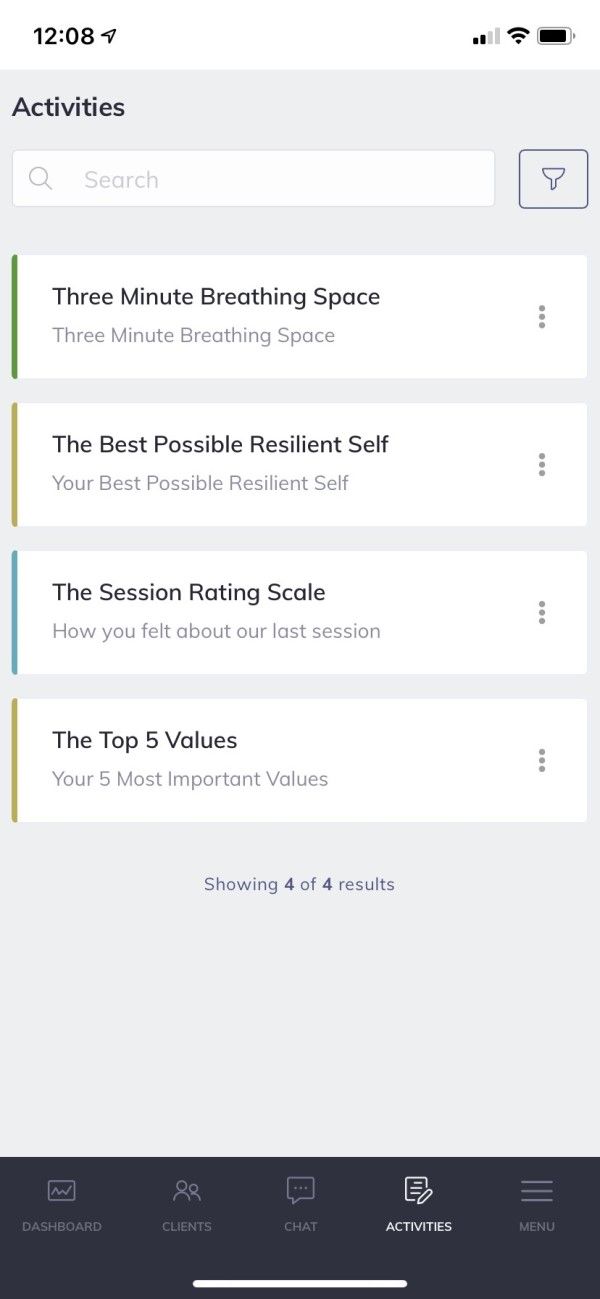19 Top Positive Psychology Interventions + How to Apply Them
 For many years, the prime focus of psychology was to diagnose and treat people with mental health problems and psychopathological issues.
For many years, the prime focus of psychology was to diagnose and treat people with mental health problems and psychopathological issues.
However, this focus began to shift in 1998, when Dr. Martin Seligman and Dr. Mihaly Csikszentmihalyi popularized the concept of positive psychology, an offshoot of clinical psychology that crafted new, positively focused interventions.
According to this new positive psychology paradigm, individuals were encouraged to work with their inner strengths to promote flourishing and the optimal functioning of people, groups, and institutions (Gable & Haidt, 2005).
This new focus represented a dramatic shift from the earlier problem focus that dominated psychological thinking for many years and continues to shape psychological interventions today.
In this article, we’ll explore how positive psychology can serve not only as a remedy for problems but also as a framework to make our work, studies, and personal lives more fulfilling.
Before you continue, we thought you might like to download our three Positive Psychology Exercises for free. These science-based exercises will explore fundamental aspects of positive psychology including strengths, values and self-compassion and will give you the tools to enhance the wellbeing of your clients, students or employees.
This Article Contains:
- What are Positive Psychology Interventions?
- Combining Positive Psychology Interventions with Digital Tools
- Types Of Positive Psychology Interventions (PPIs)
- How Do They Work?
- How Effective are They?
- A Look at the Research Article: Positive Psychology Progress: Empirical Validation of Interventions
- 5 Examples of Interventions in Use
- A List of Positive Psychology Interventions
- 4 Interventions Designed to Promote Wellbeing
- Using Interventions in the Workplace
- 4 Interventions to Use in a Working Environment
- How Can Interventions be Used to Increase Student Happiness?
- 5 Interventions to Use in School
- Interventions to Use with Depression
- A Take-Home Message
- References
What Are Positive Psychology Interventions?
Positive psychology interventions, or PPIs, are a set of scientific tools and strategies that focus on increasing happiness, wellbeing, and positive cognitions and emotions (Keyes, Fredrickson, & Park, 2012).
Existing research shows that over the years, psychologists have focused more on treatment than on prevention (Bolier et al., 2013). Psychotherapy and assessments developed and popularized in the past mostly offered solutions to anomalies like depression, anxiety, stress, panic, and trauma, etc.
There was a little resource available, until the last two decades, on tools that could flourish and promote individual wellbeing, even in the absence of any psychopathological conditions.
Sin and Lyubomirsky (2009) defined PPI as a psychological intervention that primarily focuses on raising positive feelings, positive thoughts, and positive behavior. According to Sin and Lyubomirsky, all positive psychology interventions have two essential components:
- Focusing on enhancing happiness through positive thoughts and emotions
- Sustaining the effects for long-term
Studies have suggested that happiness can be achieved and enhanced through various channels, including sensory awareness, social communication, gratitude practices, and cognitive reformations. As such, all these factors were clustered together in practical techniques called the positive psychology interventions (Parks & Schueller, 2014).
These measures were applied in both clinically distressed and non-distressed populations, and the results were consistent in both the instances (Bolier et al., 2013). By far, the most detailed definition of PPI was proposed by Parks and Biswas-Diener in 2013. According to them, positive psychology interventions are the ones that:
- Have an existing body of research to support its reliability
- Address one or more constructs of positive psychology
- Are scientifically proven and evidence-based
- Benefit us for a lifetime
Combining Positive Psychology Interventions with Digital Tools

For instance, some interventions may span several weeks or months and require the guidance of a coach or therapist. Others may comprise just a single activity that a person can choose to complete independently.
Likewise, interventions will differ in whether they encourage individuals to interact with others out in the world or spend some time engaged in quiet meditation or reflection. This article will explore a broad range of interventions that cover all these possibilities.
If you are a coach or therapist, you may find value in applying different combinations of interventions with your clients.
To achieve this, many therapists and coaches assign take-home interventions (or homework) as part of a holistic treatment solution using blended care solutions, such as the platform Quenza.
Tools such as this allow coaches and therapists to assign take-home activities to their clients digitally, which they can then complete on their own smartphone or tablet. These activities can include standardized assessments, reflection exercises, and even audio or video meditations.
Using Quenza, therapists and coaches can even combine a range of simple interventions into a unified pathway for the client to complete over several weeks, with automatically scheduled reminders and deadlines. The therapist and client can then track these deadlines via Quenza’s smartphone or desktop app.
Types Of Positive Psychology Interventions (PPIs)
In terms of content, a review of the literature reveals that PPIs can be divided into seven categories (Parks & Schueller, 2014).
1. Savoring PPIs
Savoring interventions focus on a particular experience and aim to enhance their effects for maximizing happiness (Peterson, 2006). The core principle of these interventions is to encourage the person to grab every little aspect of experience – physical, sensory, emotional, or social (Kabat-Zinn, 2009).
Due to its emphasis on wholesome perception, the savoring PPIs resemble mindfulness strategies, but they are not entirely alike.
Savoring interventions can be connected to everyday experiences like eating, smelling, or observing, only with a little more orientation and focus to what we are consciously attending to (Bryant, Smart, & King, 2005). Savoring PPIs can be reliably used for treating depression and mood disorders, as they produce happiness and self-satisfaction (Bryant, 2003).
2. Gratitude Interventions
Steve Maraboli said, “If you want to find happiness, find gratitude” – which is precisely the target of gratitude-based positive psychology interventions. Gratitude evokes strong feelings of positivity in the person who gives it and the person who receives it (Parks & Schueller, 2014).
Gratitude interventions are categorized into two parts:
- Self-reflective practices, for example, writing a gratitude journal that we keep to ourselves and use as a tool for self-expression.
- Interactive methods where we actively express our gratitude to others by saying ‘thank you,’ giving small tokens of appreciation, or paying gratitude visits.
No matter what type of practice we follow, gratitude interventions have proven benefits in increasing happiness and satisfaction (Wood, Froh, & Geraghty, 2010). It is such a powerful emotion, that by merely identifying and naming the incidents and the people we would like to thank, we can feel more positive and motivated from the inside (Emmons & McCullough, 2003; Seligman, Steen, Park, & Peterson, 2005).
3. Kindness Boosters
Kindness is a trait all happy people possess. Studies have shown that happiness and kindness go hand in hand and complement each other (Aknin, Dunn, & Norton, 2012).
Positive psychology interventions focusing on compassion can be simple acts like buying someone a small token of love, volunteering for a noble cause, donating something, or helping a stranger in need. Kindness reinforces happiness and positivity.
An example of a related PPI is ‘prosocial spending’. The activity includes willingly buying something for someone as a gesture of goodwill. It can be anything like taking your spouse out for a romantic dinner at your favorite place, giving your child the toy he/she has been asking for, or buying a meal to the homeless person you see every day at the bus stop.
It is not about how much money you spend. The goal of kindness activities is to promote happiness through such altruistic and selfless contentment (Howell, Pchelin, & Iyer, 2012).
4. Empathy PPIs
Empathy-oriented PPIs focus on strengthening positive emotions in interpersonal relationships. Healthy social bonds – both at personal and professional fronts are essential for happiness and inner peace. (Diener & Seligman, 2002).
PPIs that promote empathy include activities like self-love meditation and mindfulness practices, where individuals create positive feelings toward themselves and others by being more mindfully connected to the present (Fredrickson, Cohn, Coffey, Pek, & Finkel, 2008).
Empathy-based interventions focus on building relationships through effective communication, broadened perception, and bridging the gap between self and others (Davis et al., 2004).
The core principle behind this is to let us understand others’ perspective and build a strong connection to them (Hodges, Clark, & Myers, 2011).
5. Optimistic Interventions
Optimistic interventions create positive outcomes by setting realistic expectations. An example of an optimistic PPI is the ‘Imagine Yourself’ test where participants are asked to note down where they see themselves in the future.
Evidence suggests that although this may seem to be an easy task, non-directed imagination is a great way for people to understand how positive they are about themselves and others in life (King, 2001).
Another interesting optimism oriented PPI is the Life Summary technique that was administered by Seligman, Rashid, and Parks in 2006. This practice involves assuming that we are happy and prosperous in our lives and writing a summary of our lives based on that assumption.
The review focuses on our strengths, our achievements, and all the fruitful aspects of our lives so far. The method works exceptionally well in gaining insight into where we are going wrong in our daily lives and what we can do to pursue the ideal life we want to.
6. Strength-Building Measures
Strength in positive psychology refers to internal capacities and values (Parks & Biswas-Diener, 2013).
Studies have illustrated that awareness and acknowledgment of power help in reducing symptoms of depression and increases self-contentment (Seligman et al., 2005). As the famous saying goes, “It is within yourself that you will find the strength you need,” strength-based PPIs convey a similar message.
They are what psychologists refer to as ‘practical wisdom’ (Schwartz & Sharpe, 2006) and help us use our vitality wisely.
7. Meaning Oriented PPIs
This category of PPIs helps in understanding what is meaningful to us in life and why, and what we can do to achieve the things that matter in life. A person who has clarity of goals and expectations is more likely to feel happier and content (Steger, Kashdan, & Oishi, 2008; Steger, Oishi, & Kashdan, 2009).
If we follow Abraham Maslow’s Theory of Need Hierarchy, the highest level of human needs include self-enhancement and self-esteem, both of which are intertwined with finding the true meaning of life.
Meaning-oriented PPIs include activities like finding meaning in our daily activities, setting realistic goals and employing effective means to achieve them, or just reflecting on our thoughts and emotions (Grant, 2008).
Meaning-oriented PPIs are widely used for treating stress disorders, especially PTSD, where a person needs guidance to find the lost happiness in life and cope with the after-effects of a disaster (Folkman & Moskowitz, 2000).
How Do They Work?

Today, these interventions are being widely used in fields such as mindfulness, life coaching, relationship counseling, and general psychotherapy as well. The reason why many therapists are replacing their traditional methods with positive psychology intervention and therapies is their investigative quality.
PPIs never rely on symptomatic treatment or a quick relief. Whether treating a psychopathological condition or guiding someone to improve their wellbeing, PPIs target to dig into the root cause of the trouble. Not only that, but it also lets the individual realize the source of his/her problems and enlighten them to embody the changes wholeheartedly.
There are overwhelming pieces of evidence and research findings that suggest the effectiveness and efficacy of positive psychology interventions. However, why they work so well, and how their effects are so deep-rooted is still a vast area of study.
A study conducted on the role of time focus and the effectiveness of PPIs revealed that the two operating factors that contribute to the success of these interventions are – a shift of attention from negative to positive and internalization of positive emotions.
The study was conducted on a sample size of 695, and each of the participants was assigned to either an experimental group or a controlled group. Results showed that subjective feelings of wellbeing significantly improved from pre- to post-intervention, indicating the effectiveness of the PPIs in real life (Wellenzohn, Proyer, & Ruch, 2016).
How Effective are They?
Positive psychology encompasses both treatment and prevention.
PPIs can be useful for treating depression, anxiety, and stress disorders (Seligman, Rashid, & Parks, 2006). This fact was validated in a study conducted on terminally ill adolescent patients. The purpose of the experiment was to evaluate how positive thinking influenced coping strategies and helped the patients battle their disease with resilience.
In the study, teenager cancer patients were treated with PPIs and showed improved coherence and better stress management. The study was a milestone in the field of positive psychology as besides proving the effectiveness of these interventions; it also showcased the incredible power adolescents possess when it comes to dealing with life-threatening situations or critical health conditions.
Fordyce’s 14 Fundamentals Of Happiness
The effectiveness of positive psychology interventions was also proved by Michael Fordyce (1977, 1983) whose study found that some students in a happiness program derived more happiness because of the fourteen fundamentals of happiness psychology.
Fordyce’s fourteen fundamentals include:
- Being more active and busy
- Spending more time socializing
- Being productive at work
- Being more organized and well-planned
- Reducing worries and negative contemplations
- Fewer expectations, and having more realistic ones
- Practicing positivity through optimistic thinking and reasoning
- Getting more focused and mindfully aware of the present
- Developing and maintaining a healthy personality
- Becoming more empathetic
- Being ourselves at all times
- Replacing negative thoughts with positive ones
- Valuing close relationships
- Thinking about enhancing our happiness
Fordyce’s findings suggested that PPIs improve our state of wellbeing permanently by impacting these fourteen fundamental factors of happiness.
A Look at the Research Article: Positive Psychology Progress: Empirical Validation of Interventions
Positive Psychology Progress: Empirical Validation of Interventions was an honest effort by authors Seligman and colleagues (2005) to outline the surprising benefits of the science of happiness and related interventions.
With a host of empirical findings, cross-cultural studies, and books (including DSM), this research paper focuses on how and why PPIs enhance individual happiness.
The roots of positive psychology lie in the pioneering theories of Rogers (1951), Maslow (1962), Erikson (1982), and Jahoda (1958), among many others. From there, researchers like Murray (2000), Vaillant (2000), and Csikszentmihalyi (1975) flourished and extended the scope of the science of happiness to understand how positive emotions and a strong character helps us to lead better lives.
The target of the research was to:
- Review and assess the recent growth in the field of positive psychology
- Explain significant chunks of evidence that promotes PPIs
- Analyze data obtained by surveys and assessments to ascertain the benefits of using these interventions in practical life.
What is CSV?
Character Strengths and Virtues (CSV) was a compact handbook of the critical aspects of positive psychology, the active interventions, and bits of evidence promoting happiness as a scientifically attainable state of mind.
Authors Peterson and Seligman (2004) argued that like the DSM or the ICD that encompass almost all aspects of psychopathologies, the CSV encircles all the tidbits of psychological wellbeing.
The research paper on Positive Psychology Progress based its explanations on the six virtues that determine how happy we feel about ourselves and the world.
| List of strengths in CSV with their corresponding characteristics | |
|---|---|
| Virtues | Characteristics |
| 1. Wisdom and Knowledge | 1. Creativity, curiosity, flexible thinking, inquisitiveness, wide perception, quick learning. |
| 2. Courage | 2. Genuineness, bravery, high intrinsic motivation, perseverance. |
| 3. Humanity | 3. Gratitude, empathy, social intelligence, emotional intelligence. |
| 4. Justice | 4. Fairness, leadership qualities, conformity, high-performing nature. |
| 5. Temperance | 5. Humbleness, self-regulation, reasoning skills, vigilance. |
| 6. Transcendence | 6. Spirituality, appreciation, hopefulness, high spirits |
The study asserted that people derive happiness according to the virtues they follow (Peterson, Park, & Seligman, 2005).
By using assessments like Beck Depression Inventory (BDI), Steen Happiness Index (SHI), and Centre for Epidemiological Studies – Depression Scale (CES-D), the research established the correlation between PPIs and emotional prosperity (Lyubomirsky & Lepper, 1999).
This research also used internet-based faculties to administer and assess the effectiveness of PPIs. Web-based tactics included encouraging participants to download free sheets of positivity inventories and based on the number of registrations per week; an estimation was reached of how curious we are about happiness (Prochaska, DiClemente, Velicer, & Rossi, 1993).
Three interventions were used in this research:
- Placebo Control Exercise – where the respondents wrote about their experiences in a journal every day.
- Gratitude Visits – where the participants wrote letters expressing their thankfulness to someone they had never thanked enough.
- The 3 Good Things Task – where the participants recorded three things in life that make them happy and explain the reason those things make them feel better.
Participants performed these tasks for seven days, and results were evaluated after that. The research work presented by Seligman and Peterson revealed the impact of PPIs on happiness levels and positive responses. Evaluation and statistical analysis showed a marked reduction in the scores of BDI and other depression scales after treating participants with positive psychology interventions.
The authors revealed that we have a natural inclination toward finding out ways to be happy, and PPIs serve this purpose accurately. This article, thus, provides a solid research base that validates the potency of PPI and PPT (Positive Psychology Therapy) in clinical and non-clinical use (Fordyce, 1977, 1983).
Read more about this research.
5 Examples of Interventions in Use
Although there are many positive psychology interventions we could mention, here is a selection of five to assess.
1. Mindful Interventions
The works of Kabat-Zinn manifested how mindfulness fosters happiness and awareness. As a positive psychology intervention, mindfulness is used in combination with other psychotherapeutic practices, life coaching, and clinical fields. The popular mindfulness-based PPIs include activities like sensory awareness, guided meditation, breath control, and careful observation.
2. Gratitude Exercises
Gratitude turns what we have into enough.
Melody Beattie
Simple gratitude practices like journaling, self-compliments, or sending thank you notes have the power to bring sanctity and authentic happiness. Studies have shown practicing gratitude exercises regularly enhance cognizance and we can derive more pleasure from social relationships (Ryan & Deci, 2001).
3. Objective Assessments
In clinical setups and counseling practices, PPIs are often administered in the form of objective measures like the Mental Health Continuum, Authentic Happiness Inventory, Orientations To Happiness Questionnaire, and Positive Relationships And The Accomplishment Scale.
These tests are mostly conducted under supervision, although some of them are self-evaluative. The scores of these interventions indicate the happiness level of the respondents and indicate how positive interventions impact them.
4. Positive CBT
Cognitive Behavior Therapy (CBT) has been there since the advent of psychotherapy and is still a widely used approach for treating many psychological disorders.
Positive CBT is a modification of the classical CBT with a shift in focus from symptom reduction to wellbeing promotion. As an intervention, CBT tries to identify the strengths of the clients rather than identifying and addressing only the manifested problems.
For example, when if a person who has been diagnosed having OCD seeks positive CBT, the therapist, besides working on reducing his obsessive ideations, will also pay equal attention to the positive sides (loving nature, communicative, insightful, etc.) of the person’ character and work on building them.
The principle of CBT is to make the individuals feel better by helping them identify their potencies (Bannink and Jackson, 2011).
5. Active Aging PPI
Active aging, also called positive aging, healthy aging, or optimal aging (Cosco, Prina, Perales, Stephan, & Brayne, 2013) promotes the idea of growing old gracefully.
Much like the famous quote by William Shakespeare “With mirth and laughter, let old wrinkles come”, the active aging PPI encourages the older population to accept their aging and live through it with joy.
A study by Vera Roos and Ronette Zaaiman (2017) on active aging revealed that older people who were guided to look into the brighter sides of life and motivated to live the rest of their lives with dignity and joy survived diseases and losses better than others.
Participants of the program, all of who were 60 or above, reported having found the lost meaning of their lives and agreed to practice positivity as a daily habit after that.
A List of Positive Psychology Interventions
The purpose of positive psychology, as announced by Dr. Carol Kauffman (2006), is to “develop sound theories of optimal functioning and to find empirically supported ways to improve the lives of ordinary and extraordinary people.”
And PPIs are the means to achieve this goal and invite happiness back in our lives. Out of the heaping PPIs that mental health professionals use today, here is a run-down of some of the popular ones that you might find useful.
The Imagined Self Technique
Imagined self is a guided PPI that involves imagining your ideal self and feeling the joy that you would have felt then. Research showed that this exercise acts as a catalyst and provokes people to enact on achieving the life they want to live and derive utmost pleasure like they imagined they would (Sheldon & Lyubomirsky, 2006).
The steps are simple:
- Imagine yourself in the future, living the life you have dreamt of – with all the people you want to share it with.
- Imagine that you achieved everything that you are struggling for now, and you are proud of your achievements.
- Immerse yourself into that imagined self of yours and try to impersonate the happiness and positivity that you think you might feel then.
- Next, ask yourself what you can do to get to that stage in life, and journal your responses.
Yoga
Positive psychology is secular in all aspects. It gives equal importance to quantitative analyzes like depression and happiness scales, and at the same time also embraces qualitative and self-enhancing practices like yoga, meditation, and mindfulness.
It envelops Buddhist principles of mindfulness and fosters spiritual liberation through yoga postures and meditation (Cerezo, Ortiz-Tallo, Cardenal, & De La Torre-Luque, 2014; Cohn, Pietrucha, Saslow, Hult, & Moskowitz, 2014). Any yoga practice, be that flow meditation, hatha yoga, or other popular methods, renders a relaxing feeling to the mind and the body and is a feasible way to enhance subjective feelings of wellness.
If you are a beginner, here is a snippet of some positivity enhancing yoga techniques that you can follow.
Yoga for self-doubt
Positive energy-boosting yoga
Meditation for positivity
Yoga for self-confidence
Forgiveness Exercise
Holding on to grudges and complaints sucks out our inner peace and prosperity. A beautiful positive psychology intervention that we can follow as a daily practice and imbibe into our personality is the art of forgiving.
This exercise helps us to free ourselves from past resentments and focus on life in a brand new way. And the practice is uber simple.
- Take a piece of paper and name all the people and the incidents of the past that hurt you.
- Beside each name, describe how the negative encounter shattered you. Try to name all the feelings you experienced in that phase (for example – sad, angry, insulted, hopeless, heartbroken, betrayed, hateful, and the like).
- While you are scribbling about all the hurtful encounters, notice how those depressing feelings start coming back to you.
- Now, close your eyes, take two deep breaths and relax for a few seconds.
- Next, imagine each name on the list and in your heart, say ‘I forgive you’. Alternatively, if you were at fault, admit it and ask for their forgiveness.
- Notice how this exchange of forgiveness liberates you from the pent up grudges and make you feel empowered from the core.
- Open your eyes and on the paper where you had listed the grievances, write in bolds, FORGIVEN and FREE.
Positive Affirmations
Positive affirmations, like compliments, are “verbal sunshine” that brings an immediate sense of pleasure and pride in us. As a PPI, affirmations redirect the mind to focus on the positive sides in ourselves and push ourselves to act positively. They can be simple statements that we say aloud to ourselves every day.
Here are some positive affirmations that we can choose to say to ourselves and let the light enter in our mind, as happiness is a choice that we should make every day.
- I deserve to be happy
- I love my body and my mind deeply
- Today, I will reflect only on the good things in life
- I forgive myself for all past mistakes
- I hold no grudges against anyone
- Whatever has happened, is for the good
- I will live in the present
- From today, I will abandon old habits and embrace new and better ones
- I am grateful for everything I have got so far
- I am a fighter, and I will overcome this
- I will love myself more from today
- Everything is okay and I am at peace with myself
4 Interventions Designed to Promote Wellbeing
Although there are a great many interventions dedicated to promoting wellbeing, only four are mentioned below which are well-known and easy to apply.
1. Have-a-Good-Day Exercise
Available from the Positive Psychology Toolkit©, this exercise helps users generate new insights about what makes for a good day and set new goals to strengthen daily wellbeing.
The thinking behind the exercise is that most of us have never deliberately thought about what makes for a good day. However, by stopping to consider how daily events align with our preferences, we can take control of our own happiness.
The activity proceeds in a series of three steps.
First, clients are invited to take two weeks (or a month) to rate their impression of each day on a scale ranging from ‘It was one of the worst days of my life’ (1) to ‘It was one of the best days of my life’ (10). In addition to providing these ratings, clients will keep track of the activities undertaken on those days.
Secondly, clients will respond to a series of open-ended questions exploring the commonalities between the activities that made some days pleasant and some days less pleasant.
Finally, clients will reflect on their previous answers to identify strategies to weave more positive events (and fewer negative ones) into their average day.
If you’re interested, you can find more information on the Have-a-Good-Day exercise by accessing it in the toolkit.
2. Wellness And Wellbeing Workbook
Dr. John Barletta, a well-known Australian Clinical Psychologist, gave a list of some useful PPIs that helps to enhance mental wellbeing and promote happiness.
He uses the worksheet in his practice, as well as in his mentoring sessions, and the exercise includes fifteen prompt-based and self-assessable questions that render immediate clarity to the respondent in terms of his goals, his way of thinking, and what aspects of life can be modified to bring more happiness.
Here is the worksheet.
3. Because I Am Happy – A Happiness Guide
Dr. Scott Bolland and Dr. Bernadette Alizart designed this manual and call it the ‘hidden driver of success’. It comes as a handbook and besides having easy-to-follow PPIs, also contains valuable resources and orientations about the science of happiness. With beautiful pictorial descriptions, relatable references, and point-blank practical tips, this is a valuable resource that we can follow to let happiness in our lives.
Here is the guide.
4. Action For Happiness
The ‘Action for Happiness’ worksheet is a set of exercises explicitly promoting and enhancing happiness in our lives. The activities are objective, easy to administer, and is designed in a beautiful way that will grab eyes instantly.
Know more about this manual.
Using Interventions in the Workplace

With high rates of clinical depression, poor work-life balance, and stress disorders among professionals all over the world, promoting happiness at work is a sheer necessity now.
According to Shawn Achor, “Happiness inspires productivity” at work, and this is the primary driving force behind implementing positive psychology principles at work.
Using PPIs at the workplace promote a healthier and better performance culture. The PPIs that are executed focus on elements like – empathy, meaning, communication, strong character, and self-confidence, with a target on creating job satisfaction, emotional resilience, and healthy competition among employees.
Workplace environment traces how an individual accepts and reacts to the different pros and cons of his work life (Hart & Cooper, 2001).
PPIs in the workplace can be implemented in various forms, such as:
1. Mindfulness Programs at Work
Organizing mindfulness campaigns at the workplace is a growing trend nowadays. These programs focus on building emotional awareness at work, enhancing decision-making power, fostering self-esteem and expressing gratitude.
Example of such training is the Mindfulness At Work program that delivers an array of useful work-related mindful exercises that promote the overall wellbeing of employees and managers.
2. Health Promotion Workshops
We know that “Happiness is the highest form of health” – Dalai Lama.
An individual who is struggling with health conditions is less likely to derive pleasure at work. Health promotion in the workplace is beneficial in many ways.
- It promotes awareness of different health issues that may be related to stress and burnout.
- It reduces employee dissatisfaction that leads to unexpected resignations and absconds from work.
- Health awareness curtails health insurance burdens from organizations.
- It ensures a healthy work-life balance among employees.
5 Interventions to Use in a Working Environment
Certain criteria apply in a work environment which forces a strategic selection of interventions, and with that in mind, the following five interventions are proposed for a work environment.
1. The Innovation Time Technique
This is a very popular workplace related PPI, where the participants are encouraged to spend some time brainstorming and pursuing their passion project. The motive of this intervention is to let the individuals enjoy autonomy and invest in something they love to engage in.
2. Gratitude Interventions
Gratitude interventions in all forms are an essential part of PPIs at work. They are used alone or in combination with other interventions with the purpose of enhancing self-contentment and joy among employees.
Some examples of gratitude interventions include:
- Gratitude journaling
- Group gratitude exchange sessions
- Sending gratitude notes
- Self-gratitude exercises
- Guided gratitude meditation
3. Feedback Mechanisms
Feedbacks are a great source of self-improvement. Employees who can accept criticisms and use them to build their professional skills are happier and more satisfied with their jobs than others.
Some ways of incorporating active feedback mechanisms in workplace PPIs are:
- Daily stand-ups where employees and supervisors discuss their progress and share their plans ahead.
- Feedback assessments and surveys administered frequently.
- One on one feedback sessions where both the employee and the supervisor have the freedom to present their opinions and work for a peaceful resolution.
4. Stress Management Exercises
Stress and burnout is an integral part of most professions. Stress management exercises and assessments are a sure shot way to promote the overall physical and mental wellbeing of employees and managers.
Here is an article discussing successful workplace stress management.
5. Self-Management And Emotional Awareness
Designed and used by the organization Quartner and associates, this self-management worksheet is a complete collection of the most useful pieces of information on mental health among employees and workplace happiness. The tips and exercises focus on making the respondents more aware of themselves and identify the stressors at work, thereby providing the scope for replacing their negative emotions and enhance happiness at work.
Learn more about this exercise.
How Can Interventions be Used to Increase Student Happiness?

Her research on youth happiness in educational institutions emphasized on the use of positive psychology interventions for fostering student happiness and joy (Suldo, 2016).
The study conducted on student happiness by Lea Waters (2017) is noteworthy here. In her research, she mentioned that 25% of Australian adolescents suffer from mental disorders or distress owing to several factors like family disputes, financial crises, body shaming, and even due to the indirect effects of global warming.
Anxious and distressed children, according to Waters, promoting PPIs in schools by teachers or school counselors can go a long way in helping the kids out of their anxiety, depression, and stress.
Waters’ study (2017) mentioned about PPIs that are immensely effective for enhancing student happiness, some of them being:
- Hope inducing interventions like motivational speeches and one on one coaching sessions. These can help students to look ahead and understand self-worth (Snyder, 1995).
- School-based gratitude interventions like offering gifts and thank you notes. Small expressions of gratitude enhanced life-satisfaction and reduced symptoms of depression among the students (Froh, Sefick, & Emmons, 2008).
- Peace-enhancing positive psychology interventions like mindfulness practices, compassion exercises, and group meditation sessions that helped students discover serenity and release stress (Keegan & Barrere, 2009; Levine, 2009).
4 Interventions to Use in School
Below you will find interventions that can be very empowering in a school environment and have a lasting impact.
1. Character Strengths
Professors Chris Peterson and Martin Seligman named the Character Strengths test as the VIA Classification of the CSV Model, VIA standing for Values in Action. The intervention targets working on these six character strengths:
- Wisdom and knowledge
- Courage
- Love
- Justice
- Temperance
- Transcendence
(Peterson & Seligman, 2004).
2. Positive Relationships Intervention
This intervention is flexible and straightforward. It involves some structured open-ended questions that students answer. The questions are insightful, thought-provoking, and look something like this:
- Think of a family member you admire and mention why
- Mention one strength that your friend has
- Write about someone who has struggled in life and have come out of it successfully
- For the person you mentioned above, write about the skills that you think helped him fight stress and get his happiness back
3. Bounce Back Resilience Program For Kids
This PPI builds wellbeing by making students more emotionally resilient. It is great for children from kindergarten to middle school standards. The program focus on strategies that help young ones understand and cope with life stressors with more efficacy.
The contents of the program help kids to identify their emotions, bounce back from the sadness and chase their aspirations.
4. The Passport Program
Passport program is used in schools, training, and workshops for adolescents, usually in grades 9-12. The intervention aims to prevent depression among kids by promoting positive education concepts like self-confidence, self-esteem, problem-solving, adjustment, and decision-making.
The curriculum comes in a handy booklet form.
Interventions to Use with Depression
Dealing with depression is like “being colorblind and constantly told about how the colorful the world is” – Atticus. Positive psychology contributed a lot in helping people understand and fight depression. Here are some PPIs that help people overcome ‘the blues’ and look into the brighter sides of life.
MoodJuice Self-Help Depression Guide
The MoodJuice workbook helps in identifying the symptoms of depression, acknowledging the same, and find ways to overcome it. The exercises involve multiple choice questions related to our thoughts, feelings, and physical symptoms, and the scores indicate the intensity of the depression symptoms.
With lucid pictorial explanations and evidence-backed examples, this workbook is the first choice for many professionals and help-seekers dealing with depression.
Depression Self-Management Toolkit (DSMT)
Created by Angela Gervais and Sheila Olver Szakács, leading professionals in the field of mental health and occupational therapy, the DSMT is a step-by-step guide to fight depression in an organized way.
The toolkit contains brief explanations of the causes and symptoms of depression, followed by standardized tests and assessments to understand the severeness of the present condition. The exercises focus on allied conditions that are related to depression such as physical disorders (hypertension, cardiac dysfunction, sleep disorders, etc.) and stress, and focus on alleviating each negative aspect from its very core.
Antidepressant Skills Workbook
The Antidepressant Skills Workbook (ASW) is a collection of all the essential strategies that help in fighting and overcoming depression.
Authors Dr. Dan Bilsker, Dr. Randy Paterson, have put their years of research into this manual that shows us how by shifting focus from the negative to the positive, we can emerge as happier individuals and combat depression with a very scientific approach.
A Take-Home Message
Happiness is always there around us; we only need to look for it in the right place. As Colette had beautifully put it,
“What a wonderful life I have… I only wish I had realized it sooner”.
Positive psychology is not a resort to fight distress or disappointments. It is a gentle way of reminding us that life isn’t all about adding glories and abandoning pains. If we have the power to love ourselves and others, the determination to work dedicatedly, and the gift of waking up with new energy each day, we already have enough to be thankful for.
We hope you enjoyed reading this article. Don’t forget to download our three Positive Psychology Exercises for free.
- Aknin, L. B., Dunn, E. W., & Norton, M. I. (2012). Happiness runs in a circular motion: Evidence for a positive feedback loop between prosocial spending and happiness. Journal of Happiness Studies, 13(2), 347-355.
- Bolier, L., Haverman, M., Westerhof, G. J., Riper, H., Smit, F., & Bohlmeijer, E. (2013). Positive psychology interventions: A meta-analysis of randomized controlled studies. BMC Public Health, 13(1), 1-20.
- Bryant, F. B. (2003). Savoring Beliefs Inventory (SBI): A scale for measuring beliefs about savoring. Journal of Mental Health, 12(2), 175-196
- Bryant, F. B., Smart, C. M., & King, S. P. (2005). Using the past to enhance the present: Boosting happiness through positive reminiscence. Journal of Happiness Studies, 6(3), 227-260.
- Cerezo, M. V., Ortiz-Tallo, M., Cardenal, V., & De La Torre-Luque, A. (2014). Positive psychology group intervention for breast cancer patients: A randomised trial. Psychological Reports, 115(1), 44-64.
- Cohn, M. A., Pietrucha, M. E., Saslow, L. R., Hult, J. R., & Moskowitz, J. T. (2014). An online positive affect skills intervention reduces depression in adults with type 2 diabetes. The Journal of Positive Psychology, 9(6), 523-534.
- Cosco, T. D., Prina, A. M., Perales, J., Stephan, B. C., & Brayne, C. (2013). Lay perspectives of successful ageing: A systematic review and meta-ethnography. BMJ Open, 3(6).
- Csikszentmihalyi, M. (1975). Beyond boredom and anxiety. San Francisco: Jossey-Bass.
- Davis, M. H., Soderlund, T., Cole, J., Gadol, E., Kute, M., Myers, M., & Weihing, J. (2004). Cognitions associated with attempts to empathize: How do we imagine the perspective of another? Personality and Social Psychology Bulletin, 30(12), 1625-1635.
- Diener, E., & Seligman, M. E. P. (2002). Very happy people. Psychological Science, 13(1), 81-84.
- Emmons, R. A., & McCullough, M. E. (2003). Counting blessings versus burdens: An experimental investigation of gratitude and subjective well-being in daily life. Journal of Personality and Social Psychology, 84(2), 377-389
- Erikson, E. H. (1982). The life cycle completed. New York, NY: Norton.
- Folkman, S., & Moskowitz, J. T. (2000). Stress, positive emotion, and coping. Current directions in psychological science, 9(4), 115-118.
- Fordyce, M. W. (1977). Development of a program to increase personal happiness. Journal of Counseling Psychology, 24(6), 511-521.
- Fordyce, M. W. (1983). A program to increase happiness: further studies. Journal of counseling psychology, 30(4), 483-498.
- Fredrickson, B. L., Cohn, M. A., Coffey, K. A., Pek, J., & Finkel, S. M. (2008). Open hearts build lives: Positive emotions, induced through loving-kindness meditation, build consequential personal resources. Journal of Personality and Social Psychology, 95(5), 1045-1062.
- Froh, J. J., Sefick, W. J., & Emmons, R. A. (2008). Counting blessings in early adolescents: An experimental study of gratitude and subjective well-being. Journal of School Psychology, 46(2), 213-233.
- Gable, S. L., & Haidt, J. (2005). What (and why) is positive psychology? Review of General Psychology, 9(2), 103-110.
- Grant, A. M. (2008). Employees without a cause: The motivational effects of prosocial impact in public service. International Public Management Journal, 11(1), 48-66.
- Hart, P. M., & Cooper, C. L. (2001). Occupational stress: Toward a more integrated framework. In N. Anderson, D. S. Ones, H. K Sinangil, & C. Viswesvaran (Eds.), Handbook of industrial, work, and organisational psychology (Vol. 2, pp. 93-114). London, UK: Sage.
- Hodges, S. D., Clark, B. A., & Myers, M. W. (2011). Better living through perspective taking. In Biswas-Diener (Ed.), Positive psychology as social change (pp. 193-218). New York, NY: Springer.
- Howell, R. T., Pchelin, P., & Iyer, R. (2012). The preference for experiences over possessions: Measurement and construct validation of the Experiential Buying Tendency Scale. The Journal of Positive Psychology, 7(1), 57-71.
- Jahoda, M. (1958). Joint commission on mental health and illness monograph series: Vol. 1. Current concepts of positive mental health. New York, NY: Basic Books.
- Kabat-Zinn, J. (2009). Wherever you go, there you are: Mindfulness meditation in everyday life. London, UK: Piatkus.
- Kauffman, C. (2006). Positive psychology: The science at the heart of coaching. D. R. Stober & A. M. Grant (Eds.), Evidence based coaching handbook: Putting best practices to work for your clients (pp. 219-253). Hoboken, NJ: John Wiley & Sons.
- Keegan, L., & Barrere, C. (2009). Holistic serenity: Transcending the stresses of leadership. Perioperative Nursing Clinics, 4(1), 31-41.
- Keyes, C. L., Fredrickson, B. L., & Park, N. (2012). Positive psychology and the quality of life. In K. C., Land, A. C., Michalos & M. J. Sirgy (Eds.). Handbook of social indicators and quality of life research (pp. 99-112). Dordrecht: Springer.
- King, L. A. (2001). The health benefits of writing about life goals. Personality and Social Psychology Bulletin, 27(7), 798-807.
- Levine, M. (2009). The positive psychology of buddhism and yoga: Paths to a mature happiness. New York, NY: Routledge.
- Lyubomirsky, S., & Lepper, H. S. (1999). A measure of subjective happiness: Preliminary reliability and construct validation. Social Indicators Research, 46(2), 137-155.
- Maslow, A. H. (1962). Lessons from the peak-experiences. Journal of Humanistic Psychology, 2(1), 9-18.
- Murray, M. (2000). Levels of narrative analysis in health psychology. Journal of Health Psychology, 5(3), 337-347.
- Parks, A. C., & Biswas-Diener, R. (2013). Positive interventions: Past, present and future. T. B., Kashdan & J. V., Ciarrochi (Eds.), Mindfulness, acceptance, and positive psychology: The seven foundations of well-being (pp. 140-165). Oakland, CA: Context Press.
- Parks, A. C., & Schueller, S. (2014). The Wiley Blackwell handbook of positive psychological interventions. West Sussex, UK: John Wiley & Sons.
- Peterson, C. (2006). A primer in positive psychology. New York, NY: Oxford University Press.
- Peterson, C., Park, N., & Seligman, M. E. P. (2005). Orientations to happiness and life satisfaction: The full life versus the empty life. Journal of Happiness Studies, 6(1), 25-41.
- Peterson, C., & Seligman, M. E. P. (2004). Character strengths and virtues: A handbook and classification (Vol. 1). New York, NY: Oxford University Press.
- Prochaska, J. O., DiClemente, C. C., Velicer, W. F., & Rossi, J. S. (1993). Standardized, individualized, interactive, and personalized self-help programs for smoking cessation. Health Psychology, 12(5), 399-405.
- Rogers, C. R. (1951). Perceptual reorganization in client-centered therapy. In R. R. Blake & G. V. Ramsey (Eds.), Perception: An approach to personality (pp. 307–327). New York, NY: Ronald Press Company.
- Roos, V., & Zaaiman, R. (2017). Active ageing as positive intervention: Some unintended consequences. In C. Proctor (Ed.), Positive psychology interventions in practice (pp. 47-63). Cham, Switzerland: Springer.
- Ryan, R. M., & Deci, E. L. (2001). On happiness and human potentials: A review of research on hedonic and eudaimonic well-being. Annual Review of Psychology, 52(1), 141-166.
- Schwartz, B., & Sharpe, K. E. (2006). Practical wisdom: Aristotle meets positive psychology. Journal of Happiness Studies, 7(3), 377-395.
- Seligman, M. E. P., Rashid, T., & Parks, A. C. (2006). Positive psychotherapy. American Psychologist, 61(8), 774-788.
- Seligman, M. E. P., Steen, T. A., Park, N., & Peterson, C. (2005). Positive psychology progress: Empirical validation of interventions. American Psychologist, 60(5), 410-421.
- Sheldon, K. M., & Lyubomirsky, S. (2006). Achieving sustainable gains in happiness: Change your actions, not your circumstances. Journal of Happiness Studies, 7(1), 55-86.
- Sin, N. L., & Lyubomirsky, S. (2009). Enhancing well‐being and alleviating depressive symptoms with positive psychology interventions: A practice‐friendly meta‐analysis. Journal of Clinical Psychology, 65(5), 467-487.
- Snyder, C. R. (1995). Conceptualizing, measuring, and nurturing hope. Journal of Counseling and Development, 73(3), 355-360.
- Steger, M. F., Kashdan, T. B., & Oishi, S. (2008). Being good by doing good: Daily eudaimonic activity and well-being. Journal of Research in Personality, 42(1), 22-42.
- Steger, M. F., Oishi, S., & Kashdan, T. B. (2009). Meaning in life across the life span: Levels and correlates of meaning in life from emerging adulthood to older adulthood. The Journal of Positive Psychology, 4(1), 43-52.
- Suldo, S. M. (2016). Promoting student happiness: Positive psychology interventions in schools. New York, NY: Guilford.
- Vaillant, G. E. (2000). Adaptive mental mechanisms: Their role in a positive psychology. American Psychologist, 55(1), 89-98.
- Waters, L. (2017). A review of school-based psychology interventions. Retrieved from: https://www.strengthswitch.com/wp-content/uploads/2017/05/Waters-2011-Positive-psychology-review-of-school-based-programs-1.pdf
- Wellenzohn, S., Proyer, R. T., & Ruch, W. (2016). Humor-based online positive psychology interventions: a randomized placebo-controlled long-term trial. The Journal of Positive Psychology, 11(6), 584-594.
- Wood, A. M., Froh, J. J., & Geraghty, A. W. (2010). Gratitude and well-being: A review and theoretical integration. Clinical Psychology Review, 30(7), 890-905.
Let us know your thoughts
Read other articles by their category
- Body & Brain (49)
- Coaching & Application (57)
- Compassion (26)
- Counseling (51)
- Emotional Intelligence (24)
- Gratitude (18)
- Grief & Bereavement (21)
- Happiness & SWB (40)
- Meaning & Values (26)
- Meditation (20)
- Mindfulness (45)
- Motivation & Goals (45)
- Optimism & Mindset (34)
- Positive CBT (28)
- Positive Communication (20)
- Positive Education (47)
- Positive Emotions (32)
- Positive Leadership (18)
- Positive Parenting (4)
- Positive Psychology (33)
- Positive Workplace (37)
- Productivity (16)
- Relationships (46)
- Resilience & Coping (36)
- Self Awareness (21)
- Self Esteem (38)
- Strengths & Virtues (31)
- Stress & Burnout Prevention (34)
- Theory & Books (46)
- Therapy Exercises (37)
- Types of Therapy (64)






What our readers think
I am so happy to have come across your article.
I was able to access more information and learnings than I had expected.
You were so kind and generous to have shared links to free workbooks and resources.
Thank you so much.
Hi Maria,
Thank you for your sweet comment! It’s our pleasure 🙂
Kind regards,
-Caroline | Community Manager
this article is really very informative and helpful for me.
thank u 🙂
A very valuable article! Thank you so much, helped me in my assignments. I love PositivePsychology.
Hi is it possible to get all the references please? thank you so much, its helping me much on my research!
Hi Joana,
Whoops! Apologies that these references were missing. They’ve now been added at the end of the article 🙂
– Nicole | Community Manager
Will you provide your citations? Thank you very much.
Hi Leditrix,
Thanks for bringing our attention to this! These references have now been added to the end of the article 🙂
– Nicole | Community Manager
Hello there and thank you for the very helpful post! Can I request you to share a suggested list of books that get into the positive psychology interventions in more detail with examples? Are there books that cover PPIs broadly?
Thank you for your help!
Hi Adit,
Glad you enjoyed the post! We have an article on 10 must-read positive psychology books, many of which contain interventions. You can find that post here.
Hope this helps!
– Nicole | Community Manager
Can you please provide the reference for Gable and Haidt 2005? It isn’t listed. Thanks
Hi Shannon,
Thanks for bringing this to our attention the reference is as follows (and we’ll get this added to the reference list):
Gable, S. L., & Haidt, J. (2005). What (and why) is positive psychology? Review of General Psychology, 9(2), 103-110.
– Nicole | Community Manager
Could you please provide an article reference for Keyes (2002)?
Positive psychology interventions, or PPIs, are a set of scientific tools and strategies that focus on increasing happiness, well-being, and positive cognitions and emotions. (Keyes, 2002)
Hi Natasha,
Good spotting! We’ve revised this, and now the citation is Keyes, Fredrickson, & Park 2012 (you can find the book chapter here).
Thank you.
– Nicole | Community Manager